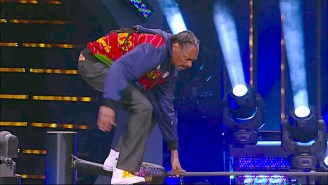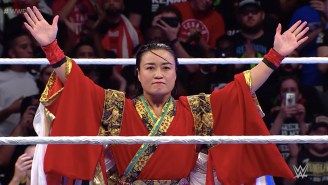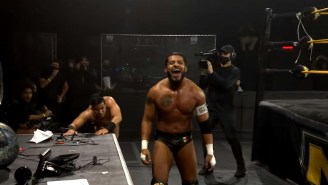In its relatively short time on television, Lucha Underground — both the show and the promotion of the same name — has been praised for helping to revolutionize professional wrestling and update the art form for a new era. While most of the praise has focused on the presentation of the show (particularly its cinematic elements), there’s another aspect of the show that has been equally important and even more revolutionary.
Week in and week out, Lucha Underground has focused on, lent gravity to and paid tribute to its Latino performers. The show is heavily steeped in authentic Aztec, Chicano and Latino iconography and history. Characters speak in Spanish, with subtitles. Aztec gods are characters and plot points. But above all, the heroes and villains of Latin heritage are fully fleshed out people with motivations, confidence and pride.
Chavo Guerrero — part of the legendary Guerrero wrestling family and a legitimate star in his own right — was originally contacted by the Lucha Underground creators to come in as onscreen talent. Those initial conversations led to him becoming a producer and behind-the-scenes force in the direction of the show, in addition to performing as one of the most despised heels in the company.
Guerrero agrees that it’s not just the production and structure of the show that sets the product apart. It’s the entire package. “Everybody says they’re different,” says Guerrero. “‘This is a new wrestling show, this is a different wrestling show.’ And nobody is, except us. Finally, there’s something different.”
As for Lucha Underground’s decision to embrace Central American culture and iconography, Guerrero agrees that’s an important aspect of the show. “If you’re not Latino, you’re going to watch the show and go, ‘Oh, this is a great wrestling show. It’s a great show.’ And if you are Latin, you’re going to realize there’s a lot more thought put into this than just, ‘We’re gonna make a set and we’re gonna put some spray paint on the walls.’ We research this stuff and researched the seven Aztec tribes and all their ancestry.”
Indeed, the Lucha Underground Championship doesn’t have the traditional trappings of pro wrestling belts. No words at all. The massive center plate resembles an Aztec calendar, radiating out from their now-iconic “mask” logo, a symbiosis of ancient and modern Mexican culture. The secondary title in the company is the Gift of the Gods, comprised of seven Aztec medallions that represent the seven ancient Aztec tribes.
“We really try to be true to Latino culture and putting on a great show and putting on great wrestling,” says Guerrero. “There’s a lot of Ts to cross and Is to dot. There really [are]. So we try to give that best product without really insulting anyone’s intelligence. Wrestling fans are really easy. All you’ve gotta do is give them a great product and don’t insult their intelligence.
“If you are Latino, how could you not watch and enjoy being catered to? Because for so long, we haven’t been. People [who run other wrestling companies] just don’t know how to tap into that market.
“People come up to me all the time — it’s happened ten thousand times, where people come up to me and say, ‘Thank you for what you do for la raza. We don’t have anybody out there [for us]. We don’t have people in Hollywood. We don’t have people in pro basketball or pro football. But you guys represent us.’ I’m like, ‘Man, I’m just trying to feed my family.’ But now it makes me think differently. Wait a minute, I’m representing this culture, this race, this ethnicity. Man, that’s a lot of pressure. So I’ve had to make different decisions in my life and that’s why I’ve left other places and [made] different decisions in the last three or four years. [Lucha Underground] came around and it was just a perfect fit.
Guerrero recognizes that the Latino and Chicano market is woefully underserved. “There’s nothing for [Latino viewers in mainstream wrestling],” he says. “They’re basically saying ‘Here’s a Big Mac. Eat it, because that’s all there is. I know you guys like Mexican food, but sorry, this is all we’ve got.’ So I think Latinos had gotten accustomed to just watching what’s given to them.
“But now we’re giving them a product for them, but it’s not just for them, it’s for everybody, which is kind of cool. The whole Latino culture, it’s kind of very pop culture now, with low riders, and at Halloween now, everybody is doing the Day of the Dead stuff. That’s straight Latino stuff. It’s getting very pop culture and very cool. Although [Lucha Underground] is for [Latinos], everybody loves it. That’s what’s cool about it. Wrestling’s wrestling.”
In the first season of Lucha Underground, retired wrestler Konnan was featured heavily as an onscreen presence. The former nWo member is Cuban, but was one of the biggest Mexican wrestling stars of all time in the 1990s.
Konnan, like Guerrero, understands that the Hispanic community has been under-represented on U.S. television for as long as he’s been alive. “When I was growing up — I’m originally from Miami — most of my idols were on the street,” he says. “On TV, the only thing they had was like [I Love Lucy]. Desi Arnaz, who was Cuban. For a while, they had Chico and the Man, which was Freddie Prinze, who was Puerto Rican. You really didn’t have a lot of Latinos to look up to.
“It’s still kind of sad, because we’re 17 percent of the population, but we only have 3 percent representation on TV. There still isn’t a lot of Latino icons. But it’s really important to me, that for so many years I grew up watching movies where Latinos were murderers or rapists, or gardeners, or … they were always the lower strata of the economic ladder.”
Konnan’s presence on WCW Nitro every week in the late 1990s was one of the first high-profile representations of authentic, current Latino culture that wrestling fans could really latch onto. Far from the squeaky-clean babyfaces from the past, like Tito Santana or Savio Vega, or the far-too-common “Latin thug” (sometimes played by white wrestlers, as was the case with Razor Ramon), Konnan’s work as part of the nWo and the Filthy Animals was cool and current … and proud.
That’s part of what he hopes Lucha Underground is bringing to television. “It’s very important for people to see strong Latino leaders,” Konnan elaborates. “And not just Latino; youth in general. Of course I’m Latino; I’m proud of that. But I’m also a human being, so I want everybody to be able to look at what I’ve been through, where I came from, what I had to go through and what I’ve done. And hopefully that’s an inspiration for people, as cliché as that sounds.
“Every nationality, whether it’s Filipinos with Manny Pacquiao, or whoever it may be, everybody wants somebody that they can be proud of. So it’s always been very important for me to hold that mantle. And even when I went to TNA and I was doing a militant Latino [character], where if you weren’t Latino, I didn’t want anything to do with you. So I’ve always been very proud of my roots, my culture. I’ve always been very proud to represent them. That’s why Lucha Underground is so important to me, because it’s a place where lucha libre is no longer an appetizer, a side platter, or an afterthought, it’s the main entree and that’s what we do.”
Catrina, manager of Mil Muertes in Lucha Underground, is played by Karlee Perez. “It’s been very important,” she says of the company’s representation. “It’s what makes it different. It’s what makes everybody jump on board. It’s okay to do things out of the box, it’s [just] the people who have the balls to do it. The more diverse show we’re able to give people, the more important. This is a wrestling show, but it’s not. It’s a TV show. It’s important just to be able to be us and give something unique.”
The identity politics of Lucha Underground extend beyond race, of course. The company also focuses on intergender wrestling, presenting male and female wrestlers as being equally talented and able to compete against each other. Ivelisse, who is a former Lucha Underground Trios Champion, agrees that Lucha Underground puts everyone on the same footing. “We are all equals and we are all equally important in Lucha Underground,” she says. “That helps the unity a lot in the locker room and backstage. And it shows. It’s very refreshing.”
This company ethos of representation and egalitarianism is something that fans are definitely noticing. Ariana Vives, a die-hard Lucha Underground fan who has written about the company for Uproxx and Bitch Media, is Peruvian and Cuban. And the way Lucha Underground handles heritage and representation is very important to her.
Vives explains, “There’s a word known as latinidad that describes the shared experiences of Latinos (and especially U.S. Latinos) regardless of national origin, such as language, colonialism, immigration issues, the complexities of race and skin color— you know, fun stuff. So because of latinidad I can watch a Mexican-influenced show like Lucha Underground and feel like it speaks to me on a cultural level. For example, little things like Konnan saying he’d shred Cage like ropa vieja are presented as something perfectly normal. Seriously, I can’t stress how great it is to hear someone in wrestling speak Spanish and not make a ‘pollo loco lol those are the only Spanish words I know’ joke out of it.
“And I love that it’s intentional—the references/homages to aspects of Latino culture aren’t some happy accident. It tells me the crew behind Lucha Underground, at the very least, makes the attempt to understand and honor the cultures they’re borrowing from. It’s never felt like appropriation.”
Hector Diaz, an SB Nation writer and Lucha Underground fan, agrees. “I definitely pay attention to the diversity of the Lucha Underground roster,” he says. “It’s not even the diversity itself but what the writers are able to do with that diversity. The characters are so rich in their backgrounds that everyone seems to stand out to me. It’s one thing having people of color on board for a project but it’s a completely other thing to utilize them effectively.”
Both Diaz and Vives spoke about how the WWE product has at times presented Latino characters and wrestlers, but they were few and far between. To them and to other wrestling fans, these characters have felt inauthentic, or offensive, or like pandering. Lucha Underground has set itself apart by having a diverse roster with a majority of people of color. But they have gone the extra mile by treating those characters with respect and agency.
Lucha Underground is helping lead wrestling into a brave new world; one where everyone will be included and everyone has a chance to compete for the same prize.






